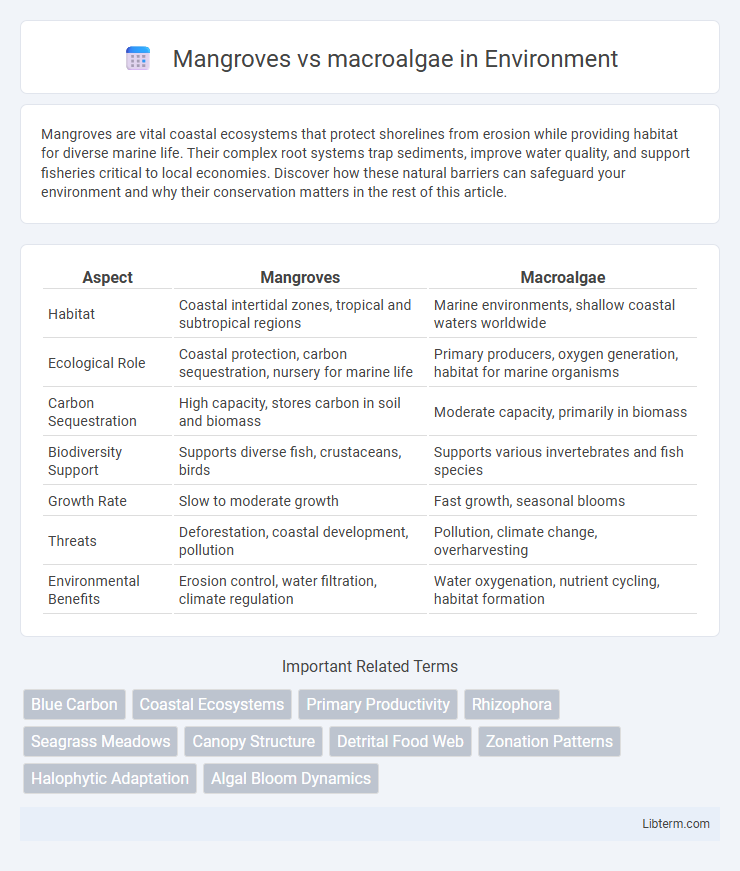Mangroves are vital coastal ecosystems that protect shorelines from erosion while providing habitat for diverse marine life. Their complex root systems trap sediments, improve water quality, and support fisheries critical to local economies. Discover how these natural barriers can safeguard your environment and why their conservation matters in the rest of this article.
Table of Comparison
| Aspect | Mangroves | Macroalgae |
|---|---|---|
| Habitat | Coastal intertidal zones, tropical and subtropical regions | Marine environments, shallow coastal waters worldwide |
| Ecological Role | Coastal protection, carbon sequestration, nursery for marine life | Primary producers, oxygen generation, habitat for marine organisms |
| Carbon Sequestration | High capacity, stores carbon in soil and biomass | Moderate capacity, primarily in biomass |
| Biodiversity Support | Supports diverse fish, crustaceans, birds | Supports various invertebrates and fish species |
| Growth Rate | Slow to moderate growth | Fast growth, seasonal blooms |
| Threats | Deforestation, coastal development, pollution | Pollution, climate change, overharvesting |
| Environmental Benefits | Erosion control, water filtration, climate regulation | Water oxygenation, nutrient cycling, habitat formation |
Introduction to Mangroves and Macroalgae
Mangroves are salt-tolerant trees and shrubs thriving in coastal intertidal zones, providing critical habitats and stabilizing shorelines against erosion. Macroalgae, commonly known as seaweeds, are large photosynthetic algae inhabiting marine environments, contributing significantly to primary production and serving as essential food and habitat for marine life. Both ecosystems play vital roles in carbon sequestration, nutrient cycling, and supporting biodiversity in coastal regions.
Key Differences in Habitat and Distribution
Mangroves primarily inhabit tropical and subtropical coastal intertidal zones with saline, oxygen-poor soils, while macroalgae thrive in a wider range of marine environments, from intertidal to subtidal zones, attached to rocks or other substrates. Mangroves form dense forests along sheltered shorelines, estuaries, and river deltas, providing critical habitat for diverse marine and terrestrial species, whereas macroalgae, including kelp and seaweed, are distributed globally across temperate and polar regions, often dominating rocky coastal areas. The differences in sediment stability, salinity tolerance, and substrate type drive the distinct spatial distribution patterns of mangroves and macroalgae in coastal ecosystems.
Morphology: Structure of Mangroves vs Macroalgae
Mangroves possess complex, woody root systems including prop and pneumatophore roots that stabilize coastal sediments and facilitate gas exchange in anoxic soils, supporting their growth in intertidal zones. Macroalgae exhibit a simple thallus structure without true roots, stems, or leaves, consisting mainly of holdfasts for attachment, stipes for support, and blades for photosynthesis, adapting them to aquatic environments. The rigid, lignified morphology of mangroves contrasts with the flexible, non-woody form of macroalgae, reflecting their distinct ecological roles and habitat requirements.
Photosynthesis and Adaptations
Mangroves and macroalgae both perform photosynthesis but differ in their adaptations to their environments. Mangroves have specialized aerial roots and salt-filtering mechanisms to thrive in intertidal zones with fluctuating salinity and oxygen levels, enabling efficient carbon fixation under stress. Macroalgae, lacking true roots, rely on their thallus structure and pigment diversity, such as chlorophylls and carotenoids, to optimize light absorption in various aquatic depths, facilitating photosynthesis in submerged habitats.
Ecological Roles in Coastal Ecosystems
Mangroves provide critical habitat for diverse marine species and stabilize shorelines by reducing erosion through their complex root systems. Macroalgae contribute significantly to primary production and serve as a food source for various herbivores, supporting nutrient cycling in coastal ecosystems. Both mangroves and macroalgae enhance biodiversity, with mangroves offering nursery grounds and macroalgae facilitating oxygen production and water quality improvement.
Biodiversity Supported by Mangroves and Macroalgae
Mangroves provide critical habitat complexity that supports diverse marine and terrestrial species, including fish, crustaceans, and migratory birds, by offering breeding grounds and nursery areas. Macroalgae, such as kelp forests and seaweeds, create underwater structures that serve as shelter and food sources for a wide range of marine organisms, promoting high species richness and ecological interactions. Both ecosystems contribute significantly to coastal biodiversity, with mangroves enhancing terrestrial-marine interface species and macroalgae sustaining vibrant underwater communities.
Carbon Sequestration and Climate Impact
Mangroves store up to 1,000 tons of carbon per hectare, making their dense root systems highly efficient at long-term carbon sequestration and mitigating global warming. Macroalgae, while less efficient in soil carbon storage, contribute significantly by absorbing CO2 rapidly through photosynthesis and exporting organic carbon to deep ocean sediments. Both ecosystems play critical roles in climate impact mitigation, but mangroves offer more durable carbon storage below ground compared to the more transient carbon capture by macroalgae.
Threats and Environmental Challenges
Mangroves face significant threats from coastal development, pollution, and climate change, leading to habitat loss and reduced carbon sequestration capacity. Macroalgae populations are increasingly impacted by nutrient pollution and rising sea temperatures, causing harmful algal blooms and ecosystem imbalances. Both ecosystems suffer from anthropogenic pressures that disrupt biodiversity and compromise their role in coastal protection and carbon cycling.
Conservation Strategies and Restoration Efforts
Mangroves and macroalgae require distinct conservation strategies due to their differing ecological functions and habitat needs. Mangrove restoration often involves replanting native species and protecting coastal zones from development and pollution, while macroalgae conservation focuses on controlling nutrient loads and sedimentation in marine environments. Effective restoration efforts integrate community engagement, monitoring programs, and adaptive management to enhance ecosystem resilience and carbon sequestration capabilities.
Conclusion: Choosing Between Mangroves and Macroalgae
Mangroves offer significant coastal protection, carbon sequestration, and habitat complexity, making them vital for shoreline stabilization and biodiversity conservation. Macroalgae provide rapid biomass growth, efficient nutrient uptake, and potential for biofuel and bioproducts, supporting sustainable aquaculture and carbon capture at a large scale. Selecting between mangroves and macroalgae depends on specific environmental goals, spatial constraints, and ecosystem services prioritized in coastal management strategies.
Mangroves Infographic

 libterm.com
libterm.com